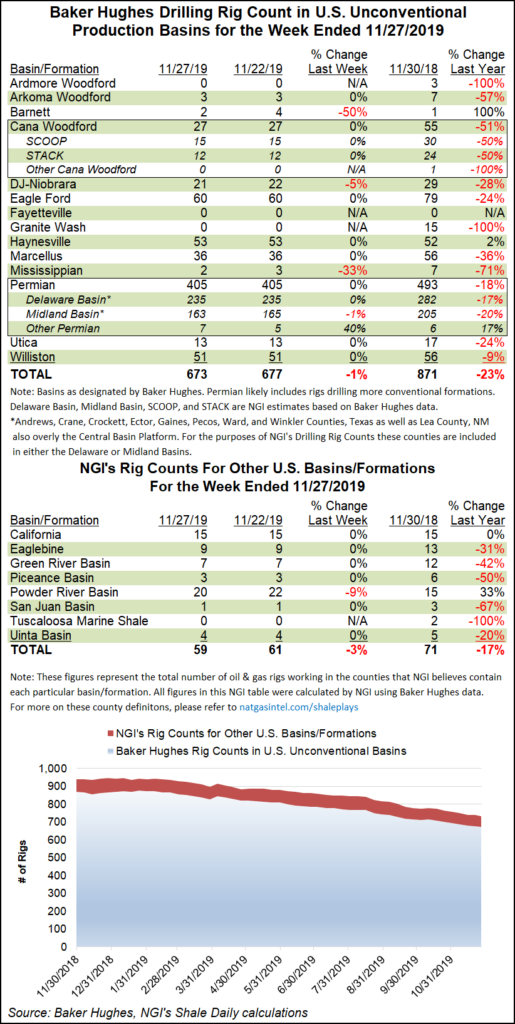E&P | NGI All News Access | NGI The Weekly Gas Market Report
U.S. Rig Count Eases Lower as Industry Breaks Early for Thanksgiving
A small decline in oil-directed activity, offset by a gain in the natural gas patch ahead of the Thanksgiving holiday, dropped the overall U.S. rig count by one unit to 802 to close out the three-day work week ending Wednesday, according to the latest numbers from Baker Hughes Co. (BKR).

Three rigs exited the oil patch for the week, partially offset by a two-rig increase in natural gas-directed drilling. That left the combined domestic count as of Wednesday down 274 units from the 1,076 active rigs at this time last year.
The Gulf of Mexico held steady at 22 rigs for the week. Two horizontal units were added in the United States, while two vertical rigs and one directional rig departed, according to BKR.
In Canada, nine oil rigs joined two gas rigs in exiting the patch, dropping the Canadian count to 126, off from 199 in the year-ago period. The combined North American rig count ended the week at 928, down from 1,275 a year ago.
Among plays, the Barnett Shale saw its total cut in half during the week, dropping from four rigs to two. The Barnett had one active rig at this time last year, according to BKR. The Denver Julesburg-Niobrara and Mississippian Lime each dropped one rig.
Among states, Alaska added two rigs for the week, growing its total to seven, versus six in the year-ago period. Louisiana added one rig week/week, while Colorado, New Mexico, Oklahoma, Texas and Wyoming each dropped one rig.
A “gargantuan” rise in Lower 48 oil and natural gas output has the United States potentially only months away from full energy independence, according to recent research by Rystad Energy.
Rystad on Tuesday pegged the domestic energy independence milestone as likely to hit by March, depending on how cold this winter is. Total U.S. oil and gas production in 2030 is expected to outpace primary energy demand in the country by around 30%.
“This milestone follows a strong period of growth in both hydrocarbon and renewable resources, and we forecast that the U.S. will have a primary energy surplus — and not a deficit — by February or March 2020, depending on the intensity of the winter season,” said Vice President Sindre Knutsson, who is on Rystad’s gas markets team.
© 2024 Natural Gas Intelligence. All rights reserved.
ISSN © 2577-9877 | ISSN © 1532-1266 | ISSN © 2158-8023 |
